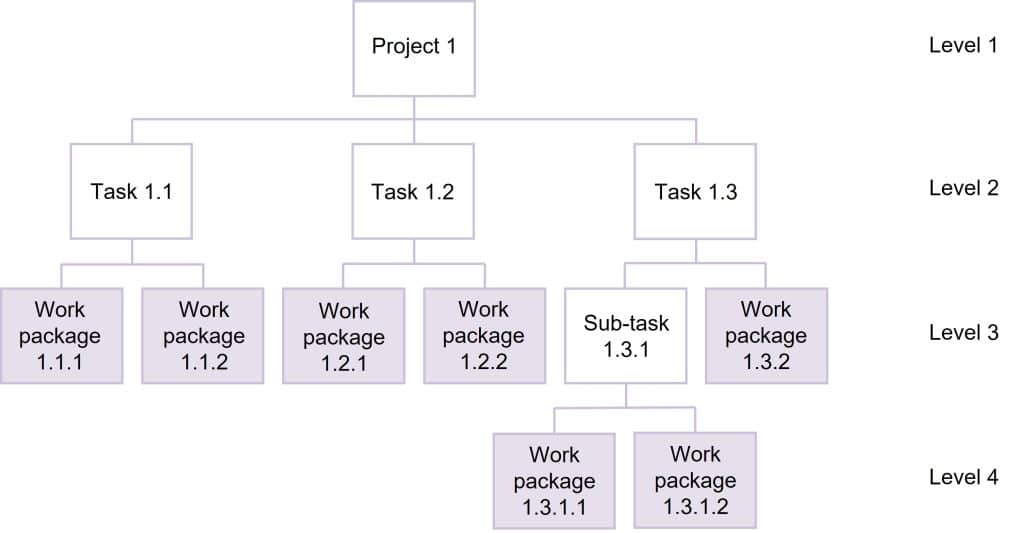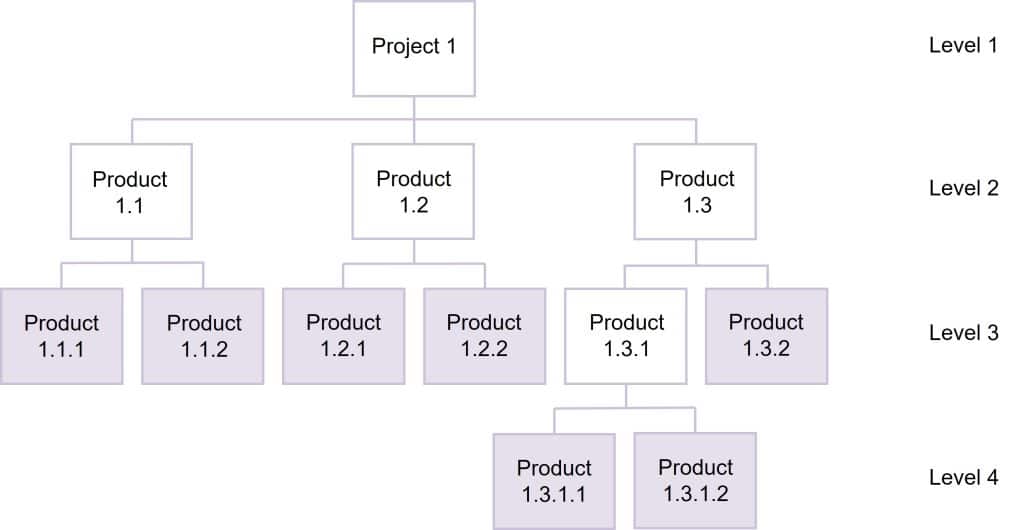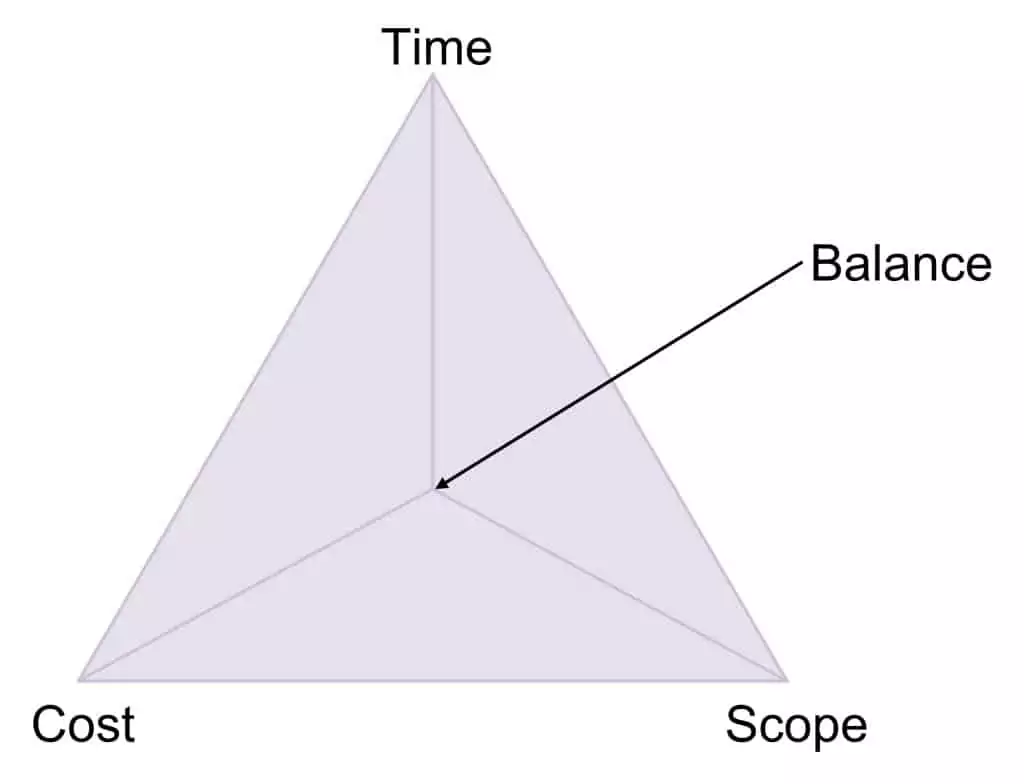Introduction
Project scope can be defined as all of the work that will be undertaken and products that will be produced by our project. Read our project scope guide to learn about the two aspects to understanding project scope – how to define it within the project and the importance of having a clear understanding of the scope.
Defining project scope
Project scope is established initially in the business case and is outlined at a high level. When we move on to creating the project management plan, the scope will be broken down in more detail. We can define our project scope using breakdown structures. These set out the requirements of the project clearly and simply. This step ensures that the project work is suitable and the project manager understands what the project entails.
Work breakdown structure (WBS)
The WBS breaks down the work required to complete a project. In order to create a WBS, we need to break the work down into work packages. Work packages are the smallest reasonable chunk of work. If you are unsure whether a task can be assigned as a work package, consider that it should be a task that can be allocated a timeline and budget for completion.
Work packages make up the lowest level of the WBS. Once we have our work packages, we can then use these to construct our WBS, which will show the full scope of work for the project.
A simple WBS might look like this:

Figure 1 A work breakdown structure.
Let us take the example of building a car. At a basic level, our car needs an engine, an interior and an exterior. These three elements can be broken down further into smaller work packages. Taking the exterior, we might say that our work packages are attaching the doors, installing the windows and painting the body. Each of these things is a task that requires time and money to complete. When creating the WBS, use the verb + noun format to designate each work package or task, e.g., attach doors, install windows, paint body. We can then follow the same process for breaking down the interior and engine components. Each of these makes up our whole car.
We now have a way of understanding the work that makes up our project scope. It is also helpful to consider the products that the project will produce as part of the scope.
Product breakdown structure (PBS)
The PBS is similar to the WBS, but it breaks the project scope down into individual products rather than work required. As with the WBS, we want to break the PBS down to its lowest level. You can use the same format for the PBS as the WBS.
A simple PBS might look like this:

Figure 2 A product breakdown structure.
Returning to the car example, let’s consider the interior. To complete the interior of our car we need to install seats and seatbelts, attach the dashboard and wire the interior lights. When creating a PBS, we simply want to state the product that we are producing. As such, we use a noun to describe each product, e.g., seats, seatbelts, dashboard, lights.
We now have a simple way of understanding the products that our project will produce as part of its scope. We can extrapolate from this to determine the work involved as well as the products produced.
Which to use when defining project scope?
So, which one should a project manager use when defining the project scope? The answer is that it will depend on the nature of your project. You could use either or both, depending on your requirements.
Using both a WBS and PBS ensures that the work and products are clearly set out. We have two good aids that enable us to quickly understand the full project scope.
However, using one or the other can be equally useful. Using the WBS, you can logically follow the work through to completion and know the products that it will produce. By using the PBS, you can work backwards and determine the work required.
Both breakdown structures are useful in defining scope. They ensure that we understand both the products that we are going to produce and the work required to achieve them, providing a useful holistic understanding of the project scope.
Why is understanding project scope so important?
Project scope encompasses all of the activities that the project will undertake. Understanding it clearly from the outset avoids confusion and reduces the risk of rework or deviation from the intended scope. In understanding the project scope, the project manager will have a clear understanding of the project work and products as a whole.
As part of our understanding of the scope, we need to consider its importance to our project. As one of the cornerstone success criteria of our project, scope is tied to time and cost. It is useful to understand this relationship and the balance that the project manager is trying to maintain.

Figure 3 The project success criteria.
There is a careful balance to be achieved between time, cost and scope. If one is a significant priority – say we have a fixed deadline (time), such as an Olympic opening ceremony – then there will be implications for the other two elements (cost and scope). We might have to increase our costs to meet our deadline and reduce our scope to ensure we can complete work in time. Whether scope is the priority or not, it is critical that we understand what our original scope is, so that we can navigate changes more effectively.
Where we have a project where scope is the priority, it is essential to have a clear understanding of exactly what that scope is. This will then allow us to allocate the appropriate amounts of time and budget to ensure we can complete all of the tasks within our project scope.
As part of establishing and detailing the project scope, we need to understand its relationship with time and cost and what impacts these might have on the scope to ensure that our project can still achieve its expected benefits through the project scope even if it changes from what was originally set out.
Summary
Understanding the project scope is fundamental to understanding the project. If the project manager has a clear view of the scope of the project, they will be much better placed to make decisions, as they will have a clear understanding of what work and/or products the project is aiming to produce. It is important to take the time to clearly define the scope. We can make use of breakdown structures to help with this. The WBS shows us the total project work, and the PBS shows the products that will be produced. Used in conjunction they give us a clear picture of the scope.
As you will have learnt in this project scope guide for beginners, project scope is one of the key success criteria of the project, and in understanding what our project is setting out to achieve, we can ensure we are working towards successfully completing it. As a project manager, if you take the time to understand the scope of your project and its significance to the project, you will be well placed to lead your project and ensure successful achievement of the project scope.